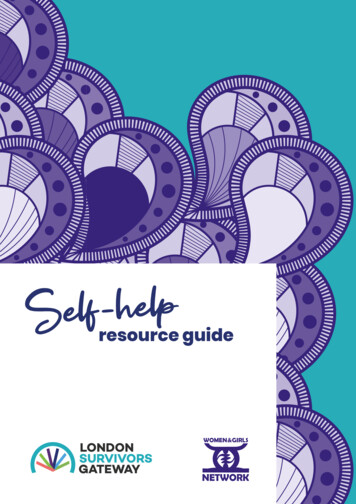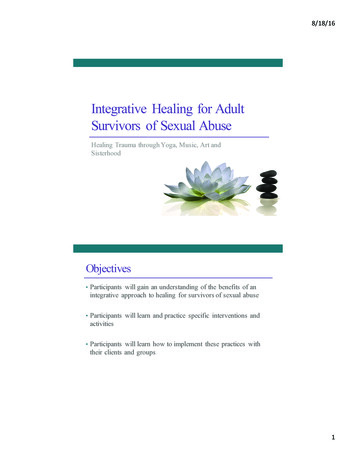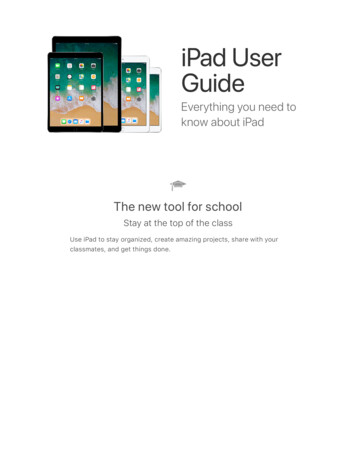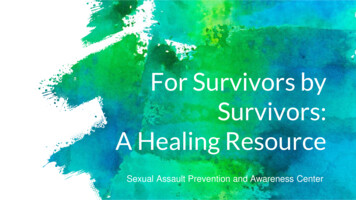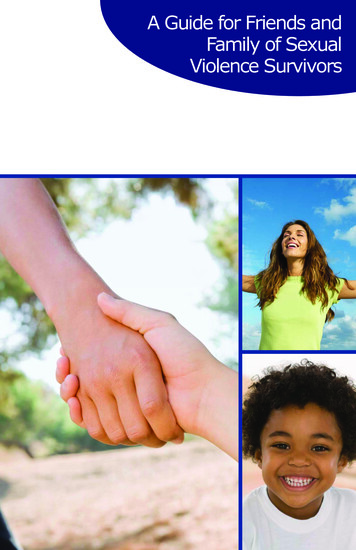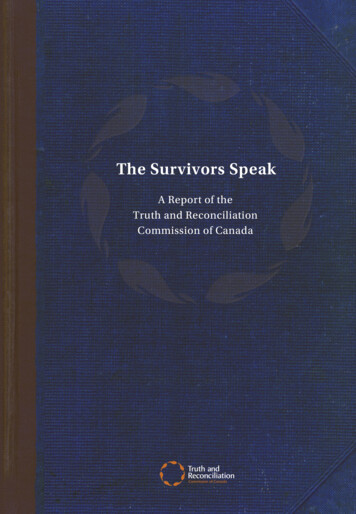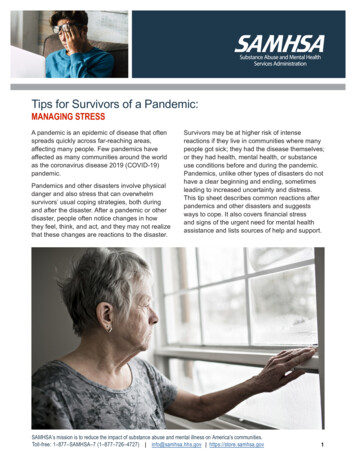
Transcription
Tips for Survivors of a Pandemic:MANAGING STRESSA pandemic is an epidemic of disease that oftenspreads quickly across far-reaching areas,affecting many people. Few pandemics haveaffected as many communities around the worldas the coronavirus disease 2019 (COVID-19)pandemic.Pandemics and other disasters involve physicaldanger and also stress that can overwhelmsurvivors’ usual coping strategies, both duringand after the disaster. After a pandemic or otherdisaster, people often notice changes in howthey feel, think, and act, and they may not realizethat these changes are reactions to the disaster.Survivors may be at higher risk of intensereactions if they live in communities where manypeople got sick; they had the disease themselves;or they had health, mental health, or substanceuse conditions before and during the pandemic.Pandemics, unlike other types of disasters do nothave a clear beginning and ending, sometimesleading to increased uncertainty and distress.This tip sheet describes common reactions afterpandemics and other disasters and suggestsways to cope. It also covers financial stressand signs of the urgent need for mental healthassistance and lists sources of help and support.SAMHSA’s mission is to reduce the impact of substance abuse and mental illness on America's communities.Toll-free: 1–877–SAMHSA–7 (1–877–726–4727) info@samhsa.hhs.gov https://store.samhsa.gov1
TIPS FOR SURVIVORS OF A PANDEMIC: MANAGING STRESSCommon Reactions to DisastersSurvivors often notice changes in their thinking,feelings, and behavior during and after a disaster,as well as physical signs and symptoms.Changes related to thinking may includenightmares, confusion, trouble making decisions,trouble concentrating, difficulty with rememberingthings, and inability to listen to others.Changes in feelings may include increased oroverwhelming fear, anxiety, depression, irritabilityand anger, hopelessness, or guilt. Survivors mayalso experience a sense of disconnection, or notcaring about things, as well as inability to feel joyor sadness.Changes in behavior may include having anexaggerated startle response, trouble sleeping, ormore arguments with others. Survivors may alsonotice that they are eating too much or too little,crying more often, having angry outbursts, orspending more time alone. Their substance usemay increase.Physical signs and symptoms may includeheadaches, stomachaches, or diarrhea; lossof appetite; sweating or having chills; tremors(shaking) or muscle twitches; higher or lowerenergy than usual; or being unable to relax.Common Reactions in Childrenand TeenagersChildren and teenagers also experience reactionsduring and after pandemics and other disasters.In fact, because they have had fewer years todevelop social, communication, and coping skillsthan adults, children may be at particular riskafter disasters. Common reactions vary by agerange.Children 5 years and younger may have persistentfear and worry; become clingy; cry or whimper;scream; have problems sleeping or havenightmares; or return to former behaviors or fears(e.g., bedwetting, thumb sucking, or fear of thedark).Children 6 to 11 years may withdraw from othersand activities; have sudden outbursts; havedifficulty concentrating; have fears; becomeirritable; feel sad or anxious; blame themselvesfor aspects of the pandemic and relatedstressors; become emotionally numb; or startperforming more poorly at school.Children 12 to 17 years may have similar reactionsto those of 6- to 11-year-olds. They may alsohave flashbacks, or sudden, upsetting memoriesof especially upsetting events associated with theToll-free: 1–877–SAMHSA–7 (1–877–726–4727) info@samhsa.hhs.gov https://store.samhsa.gov2
TIPS FOR SURVIVORS OF A PANDEMIC: MANAGING STRESSpandemic. They may engage in more risk-takingbehavior, including misuse of drugs or alcohol.If you are a parent or other caregiver, you cantake steps to help your child or teenager copewith disaster reactions. Modeling effective copingskills that include a flexible routine with plenty ofsupport, communication, and warmth will benefitthe whole family.Tips To Manage Distress Aftera PandemicCoping skills and strategies can help you dealwith the distress that is common among disastersurvivors. Modeling these strategies can also helpyour family through phases of disaster recovery.Make and Use Your Connections. Build closerelationships with others, especially with thosewho accept and understand your feelings, andtake time to enjoy the close relationships youhave. Socializing with others can reduce stressand create a sense of support and connection.Try volunteering, visiting family, calling a friend, orreaching out to a faith leader.Engage in Practices To Relax. Try to meditate,or listen to music as a way to calm yourself. Ifyou’re experiencing acute stress, you may wantto try abdominal breathing (please refer to theInstructions—Abdominal Breathing text box).News Intake. Try not to overconsume news. Doingso has been shown to increase stress levels andanxiety. It may be helpful to identify a few sourcesyou trust and plan to consult regularly; stickwith those sources; and set a daily time limit forreading, watching, and listening to news.Sense of Humor. Use humor to reduce stress.Watch a funny movie or podcast, read a goodbook, or tell a funny joke to someone you know.Physical Care. Eat healthy meals and snacks,drink plenty of water, and get enough rest. Avoidexcessive amounts of caffeine and alcohol.Model these behaviors for your family.Find Purpose. After a disaster there may be timeto reflect on what is important to you in life, andto make sure you’re spending the most timeon things that matter most to you. Take part inactivities you find enjoyable and meaningful, orcreate a plan to move in that direction.Have a Flexible Routine. Create a routine or dailyschedule. Have a plan to accomplish requiredtasks, and create a flexible routine to accomplishthem. Routines provide a sense of control overyour life and reduce stress and uncertainty.Flexible routines allow you to accommodateunexpected events or urgent needs that arisewhile also maintaining a degree of consistency.Manage Thoughts. In challenging times, it is easyfor your attention to focus more on the negative.To counter this tendency, remind yourself oftransitions and challenges you have successfullynavigated in the past. It may be helpful toremember coping methods that worked for youthen, as they may also be effective now.Instructions—Abdominal Breathing1. Lie on your back on a flat surface or inbed, with your knees bent.2. Put one hand on your chest and the otheron your belly, just under your rib cage.3. Inhale slowly through your nose towardyour lower belly. Your hand on your bellyshould rise, and your hand on your chestshould stay still.4. Tighten your abdominal muscles, and letthem fall inward as you exhale throughpursed lips. Your hand on your belly shouldmove down, back to its original position.5. Continue this process for 5 to 10 minutes.From Harvard Health Publishing, ease/learning-diaphragmatic-breathing.Toll-free: 1–877–SAMHSA–7 (1–877–726–4727) info@samhsa.hhs.gov https://store.samhsa.gov3
TIPS FOR SURVIVORS OF A PANDEMIC: MANAGING STRESSExercise. Set aside time for regular exercise orother physical activity, as research shows thisreduces stress and anxiety while also boostingphysical health. If your schedule doesn’t allowfor long segments of activity, take a couple of5-minute walks instead. Try to make regularphysical activity a part of your everyday routine.Get Outside. Visit a local park or other beautifulspace. Find time to step outside regularly andmove around. The fresh air will decrease stresswhile providing a boost to physical and mentalhealth.Write in a Stress Journal. Take 15–20 minuteseach day to reflect upon stress and write downyour thoughts and feelings. If you take timeduring the day to address stress, it is less likely atnight to interfere with sleep.Celebrate Successes, and Make Time for ActivitiesYou Enjoy. Know it is okay to experience joy in thedisaster recovery process and have moments ofsuccess even after a pandemic or other disaster.Return to doing things you enjoy with your familyand spending time with friends.What To Expect in Your Financial LifePandemics may involve intense financialupheaval and stress linked to job loss and workdisruption. The loss of a previous standard ofliving and professional identity, as well as theinability to pay monthly bills, may contribute toanger and prolonged stress and fear.Seeking financial assistance may help survivorsregain a sense of control and create a plan formoving forward. Please refer to the text box foronline resources about how to manage financesafter a pandemic.For survivors in immediate need of foodassistance, the U.S. Department of AgricultureNational Hunger Hotline nger-clearinghouse)provides information on how to access local foodresources such as meal sites, food banks, andother social services.Personal Finance After a PandemicThe Consumer Financial Protection Bureauhas information on managing finances,finding assistance, and accessing supportrelated to COVID-19: Tools To Help When You Can’t Pay YourBills: s-to-help-pay-bills A Guide to COVID-19 Economic StimulusRelief: e-covid-19-economicstimulus-checks Protect Yourself Financially: ect-yourself-financially-from-impact-ofcoronavirus Dealing With Debt: navirus-and-dealing-debt-tips-helpease-impact Tips for Financial Caregivers: icThe Federal Trade Commission hasprovided information for consumers g-your-bills-during-covid-19),as has the Federal Reserve covid-19-resources), and the U.S.Department of the Treasury has highlightedresources for financial relief after ncial-relief.Toll-free: 1–877–SAMHSA–7 (1–877–726–4727) info@samhsa.hhs.gov https://store.samhsa.gov4
TIPS FOR SURVIVORS OF A PANDEMIC: MANAGING STRESSHelpful ResourcesSubstance Abuse and Mental Health ServicesAdministration (SAMHSA)5600 Fishers LaneRockville, MD 20857Toll-free: 1–877–SAMHSA–7 (1–877–726–4727)TTY: 1–800–487–4889Email: samhsainfo@samhsa.hhs.govSAMHSA Store: https://store.samhsa.govSAMHSA Disaster Technical Assistance CenterToll-free: 1–800–308–3515Email: dtac@samhsa.hhs.govWebsite: https://www.samhsa.gov/dtacWhen To Seek Professional SupportSAMHSA Disaster Mobile AppWebsite: actions to disasters dissipate in time formany survivors. However, some survivors mayexperience reactions that persist over time, causethem significant distress, and get in the way oftheir daily lives. Survivors with a recent historyof intense stress or with health conditions beforeand during the pandemic may be at particularrisk. Following are examples of more seriousreactions after a disaster:Helplines Disorientation or confusion, and difficultycommunicating thoughts Overwhelming guilt and self-doubtNational Suicide Prevention LifelineToll-free (English): 1–800–273–TALK (1–800–273–8255)Toll-free (español): 1–888–628–9454TTY: 1–800–799–4TTY (1–800–799–4889)Website (English): https://suicidepreventionlifeline.orgWebsite (español): /en-espanol Feelings of hopelessnessTreatment Locator Limited attention span and difficultyconcentrating Frequent mood swings or continuous crying Reluctance to leave home Fear of crowds, strangers, or being alone Increased use of drugs, alcohol, or prescriptionmedicationIf you or someone you care about isoverwhelmed by stress and reactions to thepandemic, you may want to reach out forprofessional mental health and/or substance useservices and treatment. Check out the HelpfulResources section for free, confidential help withcrises and short- and long-term referrals to careand support.SAMHSA Disaster Distress HelplineToll-free (English and español): 1–800–985–5990TTY: 1–800–846–8517SMS (English): text “TalkWithUs” to 66746SMS (español): text “Hablanos” to 66746Website: helplineWebsite (espanol): helpline/espanolSAMHSA’s National HelplineToll-free: 1–800–662–HELP (1–800–662–4357) (24/7/365Treatment Referral Information Service in English and español)TTY: 1–800–487–4889Website: *Note: The views, opinions, and content expressed in this publicationdo not necessarily reflect the views, opinions, or policies of the Centerfor Mental Health Services (CMHS), the Substance Abuse and MentalHealth Services Administration (SAMHSA), or the U.S. Department ofHealth and Human Services (HHS).PEP20–01–01–020Toll-free: 1–877–SAMHSA–7 (1–877–726–4727) info@samhsa.hhs.gov https://store.samhsa.gov5
Resources section for free, confidential help with crises and short- and long-term referrals to care and support. PEP20-01-01-020. Helpful Resources Substance Abuse and Mental Health Services Administration (SAMHSA) 5600 Fishers Lane Rockville, MD 20857 Toll-free: 1-877-SAMHSA-7 (1-877-726-4727) TTY: 1-800-487-4889. Email:



